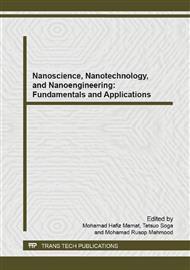[1]
Nuzaihan, M.N.M.; Hashim, U.; Nazwa, T.; Ruslinda, A.R., Fabrication of poly-silicon microwire using conventional photolithography technique: Positive resist mask vs aluminium hard mask, Micro and Nanoelectronics (RSM), 2013 IEEE Regional Symposium on , vol., no., pp.211-214.
DOI: 10.1109/rsm.2013.6706511
Google Scholar
[2]
G. Wenga, E. Jacques, A-C. Salaün, R. Rogel, L. Pichon and F. Geneste, Bottom-gate and step-gate Polysilicon nanowires field effect transistors for ultrasensitive label-free biosensing application Procedia Engineering 47 (2012) 414 – 417.
DOI: 10.1016/j.proeng.2012.09.172
Google Scholar
[3]
Cheng-Yun Hsiao, Chih-Heng Lin, Cheng-Hsiung Hung, Chun-Jung Su, Yen-Ren Lo,Cheng-Che Lee, Horng-Chin Lin, Fu-Hsiang Ko, Tiao-Yuan Huang, Yuh-Shyong Yang, Novel poly-silicon nanowire field effect transistor for biosensing application, Biosensors and Bioelectronics 24 (2009) 1223–1229.
DOI: 10.1016/j.bios.2008.07.032
Google Scholar
[4]
Hou-Yu Chen, Chia-Yi Lin, Min- Cheng,Chien-Chao Huang and Cho-Hsin Chien. Fabrication of High- Sensitivity Polycrystalline Silicon Nanowire Field Effect Transistor pH Sensor using conventional CMOS techmology.Japanese Journal of Applied Physics 50, Issue 4, (2011) pp.04DL05-04DL05-5
DOI: 10.1143/jjap.50.04dl05
Google Scholar
[5]
F. Demami, l.Pichon, R.Rogel, A.C. Salaun, Fabrication of polycrystalline silicon nanowires using conventional UV lithography, IOP Con.Series: Material Science and Engineering 6 (2009).012014.
DOI: 10.1088/1757-899x/6/1/012014
Google Scholar
[6]
C-H.Lin et al, Poly-silicon nanowire field-effect transistor for ultrasensitive and label-free detection of pathogenic avian influenza DNA, Biosensor and bioelectronics 24 (2009) pp.3019-3024.
DOI: 10.1016/j.bios.2009.03.014
Google Scholar
[7]
U.Hashim, Soon Weng Chong and Wei Wen Liu, Fabrication of Silicon Nitride Ion Sensitive Field- Effect Transistor for pH Measurement and DNA Immobilization/Hybridization, Journal of Nanomaterials, Volume 2013, art.no, 542737.
DOI: 10.1155/2013/542737
Google Scholar
[8]
Siti Fatimah Abd Rahman, Nor Azah Yusof, U.Hashim, M.Nuzaihan Md Nor, "Design and Fabrication of Silicon Nanowire based pH Sensor. International Journal of Electrochemical Science vol.8 (2013) pp.10946-10960
DOI: 10.1016/s1452-3981(23)13161-0
Google Scholar
[9]
Quirk M and Serda J., Semiconductor Manufacturing Technology, US of America: Prentice Hall, 2000.
Google Scholar
[10]
Hong Xiao, Introduction to Semiconductor Manufacturing Technology.International Edition, Prentice Hall, New Jersey, 2001.
Google Scholar
[11]
Ramachandran, N., Larson, D.N., Stark, P.R.H., Hainsworth, E., Emerging Tools for Real-Time Label-Free Detection of Interactions on Functional Protein Microarrays. The FEBS Journal 272 (2005), pp.5412-5425.
DOI: 10.1111/j.1742-4658.2005.04971.x
Google Scholar
[12]
M.Nuzaihan M.N., Uda Hashim, Taib Nazwa, A Rahim Ruslinda., Fabrication of Poly-Si Nanowire Using Conventional Photolithography Technique (2014), Advanced Materials Research, 925,pp.460-463.
DOI: 10.4028/www.scientific.net/amr.925.460
Google Scholar
[13]
S.-W. Ryu et al. Gold Nanoparticle Embedded Silicon Nanowire Biosensor for Applications of Label-free DNA detection. Biosensor and bioelectronics 25 (2010) pp.2182-2185.
DOI: 10.1016/j.bios.2010.02.010
Google Scholar
[14]
Y.Cui,Q.Wei, H.Park, and C.M. Lieber Nanowire Nanosensors for Highly Sensitive and Selective Detection of Biological and Chemical Species, Science293,2001,pp.1289-1292.
DOI: 10.1126/science.1062711
Google Scholar


